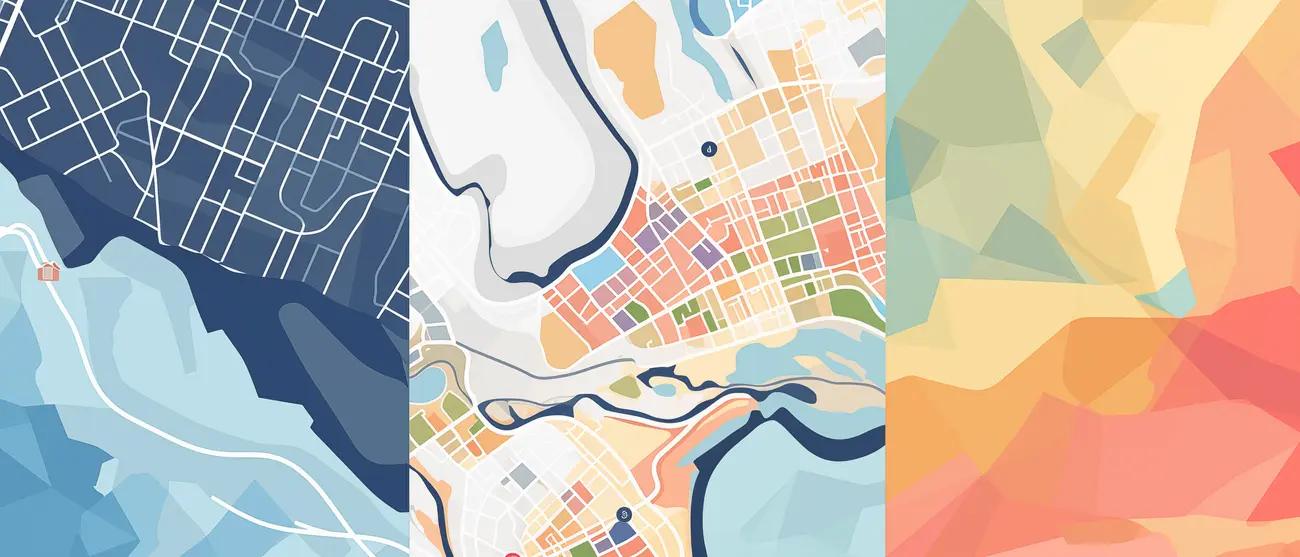In this article I will explain how you can create a basic web map with Leaflet and React by using functional components without any third party packages. So i will strongly recommend to have a look at the Leaflet API reference.
What is Leaflet?
Leaflet stands out as a versatile and free JavaScript library, empowering developers to craft seamless Web GIS applications. Leveraging HTML5 and CSS3, Leaflet is compatible with all major web browsers, providing a user-friendly platform for integrating raster and vector data from diverse sources.
Exploring React and Leaflet Integration
Diving deeper into the integration of React and Leaflet components, this article explains the process of creating a web map with fundamental features:
- Basic map using OpenStreetMap.
- Visualizing data in GeoJSON format.
Getting Started
First of all you need a react app which you can create with:
javascriptCopy codenpx create-react-app leaflet-react cd leaflet-react
and you will need to install Leaflet in your project with:
bashCopy codenpm install leaflet
After you have installed the package you can import it with import L from "leaflet" into your App.js. The import of the leaflet.css is also important because without it the map-tiles will be misplaced.
javascriptCopy code//App.js import React, { useEffect } from "react" import L from "leaflet" import "leaflet/dist/leaflet.css" const App = () => { const mapStyles = { width: "100%", height: "300px", } const layer = L.tileLayer( `https://{s}.tile.openstreetmap.org/{z}/{x}/{y}.png`, { attribution: '© <a href="https://www.openstreetmap.org/copyright">OpenStreetMap</a> contributors', } ) const mapParams = { center: [52, 4], zoom: 4, layers: [layer], } // This useEffect hook runs when the component is first mounted, // similar to componentDidMount() lifecycle method of class-based // components: useEffect(() => { const map = L.map("map", mapParams) }, []) return ( <div> <div id="map" style={mapStyles} /> </div> ) } export default App
Since Leaflet doesn't support server-side rendering, the useEffect hook ensures the map rendering post-component mounting.
javascriptCopy codeuseEffect(() => { L.map("map", mapParams); }, []);
The "map" parameter is the id of the html-element in which the map will be rendered. With mapParams you can pass some basic parameters as props for the Leaflet map. These parameters can just be created in a object Leaflet API: Map Creation:
javascriptCopy codeconst mapParams = { center: [0, 0], zoom: 0, layers: [layer] };
TileLayers with OpenStreetMap Data are created with L.tileLayer(url, options) (Leaflet API: TileLayer).
javascriptCopy codeconst layer = L.tileLayer(`https://{s}.tile.openstreetmap.org/{z}/{x}/{y}.png`, { attribution: '© <a href="https://www.openstreetmap.org/copyright">OpenStreetMap</a> contributors' });
Also some basic css in js is created for the map container which makes the map fullscreen and will be passed as style props:
javascriptCopy codeconst mapStyles = { width: "100%", height: "100vh" };
In the end you just need html element in which the map will be rendered:
javascriptCopy codereturn ( <div> <div id="map" style={mapStyles} /> </div> )
In case something didn't work out as expected you can just clone the following repositiory:
Github Repositiory: https://github.com/dietrichmax/leaflet-react-functional-component Live Demo: https://dietrichmax.github.io/leaflet-react-functional-component/
Adding GeoJSON Data
To add GeoJSON the the map first of all you will need to create a GeoJSON object:
javascriptCopy codefunction getGeoJson() { return { type: "GeometryCollection", geometries: [ { type: "Polygon", coordinates: [ [ [6.000000248663241, 56.000000155530984], [7.000000192318055, 56.000000155530984], [8.000000135973096, 56.000000155530984], [9.000000247266257, 56.000000155530984], [10.000000190921071, 56.000000155530984], [11.000000134576112, 56.000000155530984], [12.000000245869273, 56.000000155530984], [12.000000245869273, 55.000000211876], [12.000000245869273, 54.00000010058284], [12.000000245869273, 53.00000015692797], [12.000000245869273, 52.00000021327298], [12.000000245869273, 51.00000010197982], [12.000000245869273, 50.00000015832478], [12.000000245869273, 49.00000004703179], [12.000000245869273, 48.000000103376806], [11.000000134576112, 48.000000103376806], [10.000000190921071, 48.000000103376806], [9.000000247266257, 48.000000103376806], [8.000000135973096, 48.000000103376806], [7.000000192318055, 48.000000103376806], [6.000000248663241, 48.000000103376806], [6.000000248663241, 49.00000004703179], [6.000000248663241, 50.00000015832478], [6.000000248663241, 51.00000010197982], [6.000000248663241, 52.00000021327298], [6.000000248663241, 53.00000015692797], [6.000000248663241, 54.00000010058284], [6.000000248663241, 55.000000211876], [6.000000248663241, 56.000000155530984], ], ], }, ], } }
The object is wrapped in a function which will return the GeoJSON. You could also fetch a GeoJSON object from somewhere else here.
Then you will need to add the GeoJSON object to the map with:
javascriptCopy codeuseEffect(() => { const map = L.map("map", mapParams) L.geoJSON(getGeoJson()).addTo(map) }, [])
And thats it! You map should look now like this:
The code for this component looks like this:
javascriptCopy codeimport React, { useEffect } from "react" import L from "leaflet" import "leaflet/dist/leaflet.css" const Map = () => { const mapStyles = { width: "100%", height: "300px", } const layer = L.tileLayer( `https://{s}.tile.openstreetmap.org/{z}/{x}/{y}.png`, { attribution: '© <a href="https://www.openstreetmap.org/copyright">OpenStreetMap</a> contributors', } ) // This useEffect hook runs when the component is first mounted, // similar to componentDidMount() lifecycle method of class-based // components: useEffect(() => { const map = L.map("map", mapParams) L.geoJSON(getGeoJson()).addTo(map) }, []) return ( <div> <div id="map" style={mapStyles} /> </div> ) } export default Map function getGeoJson() { return { type: "GeometryCollection", geometries: [ { type: "Polygon", coordinates: [ [ [6.000000248663241, 56.000000155530984], [7.000000192318055, 56.000000155530984], [8.000000135973096, 56.000000155530984], [9.000000247266257, 56.000000155530984], [10.000000190921071, 56.000000155530984], [11.000000134576112, 56.000000155530984], [12.000000245869273, 56.000000155530984], [12.000000245869273, 55.000000211876], [12.000000245869273, 54.00000010058284], [12.000000245869273, 53.00000015692797], [12.000000245869273, 52.00000021327298], [12.000000245869273, 51.00000010197982], [12.000000245869273, 50.00000015832478], [12.000000245869273, 49.00000004703179], [12.000000245869273, 48.000000103376806], [11.000000134576112, 48.000000103376806], [10.000000190921071, 48.000000103376806], [9.000000247266257, 48.000000103376806], [8.000000135973096, 48.000000103376806], [7.000000192318055, 48.000000103376806], [6.000000248663241, 48.000000103376806], [6.000000248663241, 49.00000004703179], [6.000000248663241, 50.00000015832478], [6.000000248663241, 51.00000010197982], [6.000000248663241, 52.00000021327298], [6.000000248663241, 53.00000015692797], [6.000000248663241, 54.00000010058284], [6.000000248663241, 55.000000211876], [6.000000248663241, 56.000000155530984], ], ], }, ], } }
If you are curious how to add some more features like vector layers, some controls or markers have a look at the Leaflet API Reference and much fun playing around with your Leaflet web map created with React and functional components
